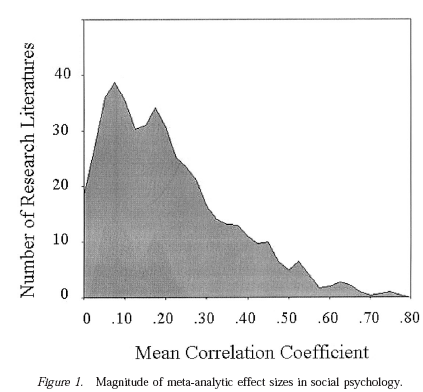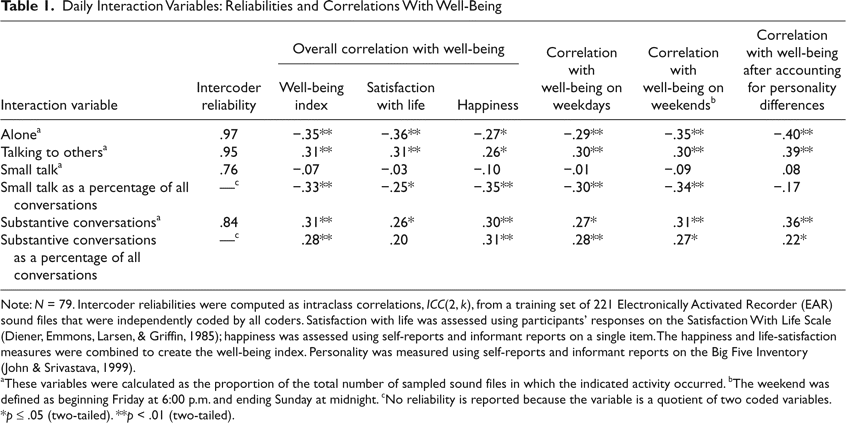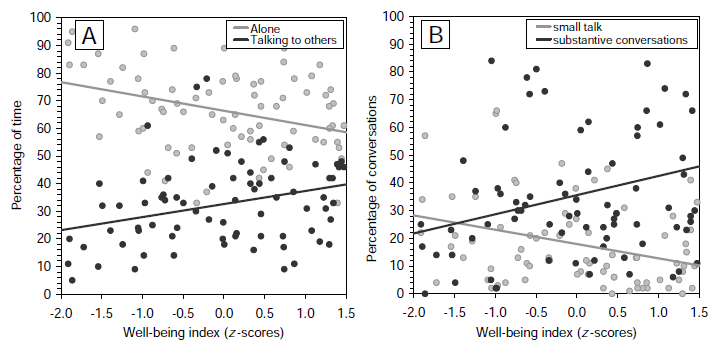Eavesdropping on (un)happiness
« previous post | next post »
Matthias Mehl et al., "Eavesdropping on Happiness: Well-Being Is Related to Having Less Small Talk and More Substantive Conversations", Psychological Science, published online 18 February 2010:
Is the happy life characterized by shallow, happy-go-lucky moments and trivial small talk, or by reflection and profound social encounters? Both notions—the happy ignoramus and the fulfilled deep thinker—exist, but little is known about which interaction style is actually associated with greater happiness. In this article, we report findings from a naturalistic observation study that investigated whether happy and unhappy people differ in the amount of small talk and substantive conversations they have.
The method:
Seventy-nine undergraduates (32 males, 47 females) wore the EAR for 4 days (Vazire & Mehl, 2008). The EAR recorded 30 s of sounds every 12.5 min, providing 23,689 waking recordings (M = 300 per participant). For each recording, coders identified whether the participant was alone or talking with other people, and whether the conversation consisted of small talk or substantive discussion. Small talk was defined as an uninvolved, banal conversation (i.e., only trivial information was exchanged; e.g., “What do you have there? Popcorn? Yummy!”). A substantive conversation was defined as an involved conversation of a substantive nature (i.e., meaningful information was exchanged; e.g., “She fell in love with your dad? So, did they get divorced soon after?”). […]
We assessed well-being with several methods. Participants completed the Satisfaction With Life Scale (Diener, Emmons, Larsen, & Griffin, 1985; α = .93) and a single-item happiness measure (“I see myself as someone who is happy, satisfied with life”) twice, 3 weeks apart. The single-item self-report of happiness was combined with reports from two to three informants per subject on the same measure, α = .80. (For details on the recruitment of these informants, see Vazire & Mehl, 2008). To obtain a multimethod well-being index, we combined (i.e., averaged) the self- and informant-based happiness measure with participants’ self-reported life satisfaction.
The results:
Here's a graphical presentation of what correlations like r=-0.33 and r=0.28 mean:
Scatterplots and linear trends for the association between participants’ well-being and aspects of their daily interactions; Panel A: Percentage of time per day spent alone and talking to others; Panel B: Percentage of conversations that were small-talk and substantive conversations.
Note: N = 79; the z-scores for the well-being index ranged from z = -2.02 to z = +1.57; for ease of graphical presentation, two data points outside of the depicted [-2.0; 1.5] range are omitted.
However, as results in social psychology go, correlations of 0.30 or so are much better than usual. Here's a figure that I've reproduced a couple of times before (from F.D. Richard, C.F. Bond, and J.J. Stokes-Zoota, "One hundred years of social psychology quantitatively described", Review of General Psychology, 2003):

Their conclusion:
Naturally, our correlational findings are causally ambiguous. On the one hand, well-being may be causally antecedent to having substantive interactions; happy people may be “social attractors” who facilitate deep social encounters. On the other hand, deep conversations may actually make people happier. Just as self-disclosure can instill a sense of intimacy in a relationship, deep conversations may instill a sense of meaning in the interaction partners. Therefore, our results raise the interesting possibility that happiness can be increased by facilitating substantive conversations. Future research should examine this possibility experimentally.
Remarking on Socrates’ dictum that “the unexamined life is not worth living,” Dennett (1984) wrote, “The overly examined life is nothing to write home about either”. Although we hesitate to enter such delicate philosophical disputes, our findings suggest that people find their lives more worth living when examined―at least when examined together.
A nice piece of work, nicely presented.
Needless to say, the journalistic uptake is another story. With some honorable exceptions, the articles tend to ignore the ambiguity of causation, and the headlines jump in several different misleading directions:
"How small talk can make you feel miserable"; "Idle chit chat can make you unhappy"; "Unhappy? Maybe it's too much small talk"; "Chit-chat can leave you miserable"; "Why too much talking can make you unhappy"; "Happy people have the gift of gab"; "Talking to others can keep you happy"; "A happy life is filled with earnest talks"; "Can you talk your way to happy?"; . . .
 Geoff Maynard's (mis-) take in the Express is especially funny:
Geoff Maynard's (mis-) take in the Express is especially funny:
BAD news today for ladies who lunch. It seems that a life of idle chit-chat can make you unhappy.
I would have thought that the topic of the conversation among the "ladies" in the accompanying illustration was likely to be right in the sweet spot of Mehl et al.'s definition-by-example of substantive conversation (“She fell in love with your dad? So, did they get divorced soon after?”).


D.O. said,
March 6, 2010 @ 8:27 pm
Of course, one should always keep in mind the third possibility, that the correlation is the result of some other (outside) force independently influencing "happiness" and "frequency of meaningful conversations".
J. Goard said,
March 6, 2010 @ 10:29 pm
Just recently, I watched Daniel Kahneman's TED talk on happiness in the "experiencing self" versus the "remembering self". Turns out that the two often differ substantially. For example, when colonoscopy patients reported their present pain level every 60 seconds, a group which had high pain followed by a quick cessation of pain was compared with a group that had similarly high pain (same duration), followed by additional pain that was less intense. Experientially, then, the second group was clearly worse, since they had the first group's pain and more. Yet it was the first group which had a significantly more negative recollection of the experience. This suggests that doctors might extend pain unneccesarily just to create a better patient memory.
So, this study seems to be using only a memory measure of happiness.
(Kahneman, BTW, is one of the founders of "behavioral economics". I've read a lot of his work, much of which I find to inform linguistic pragmatics.)
Rubrick said,
March 6, 2010 @ 11:15 pm
The tendency of journalists to assume causation where no such assumption is warranted is incredibly infuriating. I'm never sure whether it's ignorance or malfeasance (though I'm of the opinion that in journalism, ignorance is malfeasance; if you don't understand, don't write).
The research itself does seem interesting and well done, though this took me aback: "A substantive conversation was defined as an involved conversation of a substantive nature". Tautology Club, anyone?
цarьchitect said,
March 7, 2010 @ 12:04 am
Yeah, I see confounding as a very real thing here. If you're more well-balanced, aren't you likely to be more interested in other people and not dwelling on your miseries? That seems to be the case in my limited experience.
Or, perhaps, management should leave conversation cards at the watercooler to boost morale.
Stefano Bertolo said,
March 7, 2010 @ 12:21 am
It would be interesting to run some statistics on Twitter feeds to see if there is a correlation between the expression of positive emotions and depth of conversation.
Catanea said,
March 7, 2010 @ 4:36 am
And what about when I talk to my dogs? We think we are happy. They are good listeners. And I am very good at guessing what they want to say…
I suppose very few university undergraduates are able to keep pets with them, and if they were heard talking to a pet (I talk to wild birds and stray cats, too… not trees, though) would they be classified as "alone"?
John Lawler said,
March 7, 2010 @ 12:07 pm
As for cats, at least, a proximity correction has to be applied to the recorded seriousness of the discourse, but the function is well-studied (http://xkcd.com/231).
Army1987 said,
March 7, 2010 @ 12:31 pm
What the study found was that substantive conversations are correlated with well-being and that small talk isn't (the entries in the third row of the table are quite small), but what the press said suggests that small talk is negatively correlated with well-being (i.e. that the entries in the third row would be significantly negative).
Bloix said,
March 7, 2010 @ 10:18 pm
This study appears to show that people who have friends are happier than people who don't.
Don Gabor said,
March 8, 2010 @ 12:08 pm
While I agree with the University of Arizona researchers who performed the study that ‘the happy life is social and conversationally deep rather than solitary and superficial,’ the conclusions that media have taken from the study—that small talk leaves people unhappy—is misplaced. It is the inability many people have to meaningfully connect with others that leaves them unhappy and socially isolated.
I maintain that small talk is an important skill to bridge that gap and a prerequisite for more substantive conversations.
Don Gabor, author of How to Start a Conversation and Make Friends
don@dongabor.com
et said,
March 9, 2010 @ 12:17 pm
Real friends instead of acquaintances.
Happiness studies versus the examined life « Speechless said,
December 2, 2010 @ 12:47 pm
[…] Matthias R.; Simine Vazire, Shannon E. Holleran, and C. Shelby Clark. 2010-02-18. “Eavesdropping on Happiness: Well-Being Is Related to Having Less Small Talk and More Substantive Con….” Psychological Science. […]